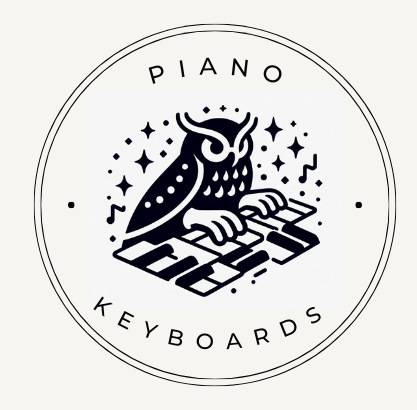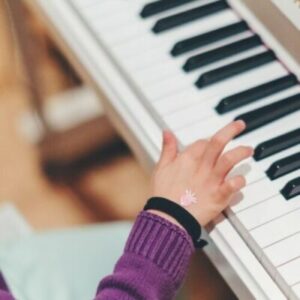You are your child has just started piano lessons, you are excited, they are excited, but then there is the question of what instrument to buy? You can find small piano keyboards in a box down a Walmart aisle for less than $100, and then you can find grand pianos for more than $100,000, so how do you choose? Chances are, you are probably not going to give much thought to the 100k piano, but you also probably imagine the $100 Walmart keyboard won’t cut it either, even for a new beginner. You may have even looked at some options on Amazon, and you find there are so many instruments in between these two extremes, so how do you know what to look for? What are the essentials, and what are the nice-to-haves? Lastly, what is unnecessary or just marketing jargon? My recommendation to someone just starting out is to buy a digital keyboard.
There are many benefits to actually choosing a keyboard rather than an acoustic piano – they don’t need to take up a lot of space, you don’t have to tune them, and keyboards even at the entry level are getting better all the time, there are plenty of options to choose from that can get you off and running for just a few hundred dollars, but there are some factors you want to see in a keyboard even for your first instrument:
- 1) Number of keys
- 2) Weighted keys
- 3) Polyphony count
- 4) Sound sampling & speakers
- 5) Quality brands
We will dive into each of these below.
NUMBER OF KEYS
A full size piano has 88 keys. Is it necessary to have a keyboard with all 88 keys? I do think it is a good idea in fact! Will you use all 88 keys from the start? No. In fact, rarely ever does one use all 88 keys. However, it is helpful for gaining perspective and getting comfortable with where the notes are on an instrument. If you are only practicing on a keyboard half the size for two years and are faced with playing a recital on a full size piano, this is enough to throw off any pianist! It doesn’t even look like the same instrument! The next size down is typically one with 76 keys, and this may very well be just fine for starting off, and the next level down is one with 61 keys. I would recommend not getting a keyboard with 61 keys unless on extreme budget constraints, and what’s more, keyboards with 61 keys typically leave out other necessary functions for a piano student, such as weighted keys, and the keys are even sometimes smaller. Believe it or not, not all keys are created equal, and sometimes manufacturers will make keys smaller, either in length or width, and this too can affect any pianist, new or experienced- you want the keys to be close to that of keys on an acoustic piano.
WEIGHTED KEYS
This is perhaps the one thing I first mention to parents looking for a keyboard for their child: “Get a keyboard with weighted keys.” While keyboards are still do not have the same feel as acoustic pianos (at least not yet), having a keyboard with weighted keys goes a long way to getting that much closer to the real thing. If you cannot afford a keyboard with weighted keys, wait to purchase until you can, it is that important. So much of the technique of playing the piano is based on “weight” of the hands, this is how you shape the music. Even when you are just starting out, even before you know any note names or what’s up from down, it’s important that the pianist always feel that the amount of sound produced is dependent on how much you press into the key. This often is linked to ‘touch sensitivity’. This resistance does vary from keyboard to keyboard, and the responsiveness is somewhat preferential with how heavy or light the keys are.
POLYPHONY COUNT
This sounds like marketing jargon, and it kind of is, but it’s the company’s way of giving a metric to the number of notes that can be played at one time. You may have experienced on very inexpensive toy pianos that after a couple notes are played, the next note you play does not sound. Why? Well, this polyphony count is quite low. If you see the polyphony is at 128 count, you are in good shape, that should do what you need it to do. You might think that’s excessive, who after all would play 128 notes at one time? You’d be surprised how the sounds quickly add up and then prevent any more sounds from occurring for a second. You may also be able to get away with 64-note polyphony to start.
SOUND SAMPLING & SPEAKERS
How companies take their sample sounds really varies. Some have recorded samples from real acoustic instruments (such as Roland), and you can hear the difference! Comparing specs across manufacturers can be a little like comparing apples to oranges; they may try and sell you on where they are getting their samples from, but if you had 10 keyboards, they may have taken 10 different results to get to their final keyboard. Yes, some will be better than others, but the best way to tell is by hearing them in the store and using your own ears. Usually, the speakers on the keyboards themselves are just okay, and while it could be connected to external speakers, I certainly don’t think this is necessary for beginners. However, even with solid polyphony count and weighted keys, this could all feel miserable if the speakers are just poor. You may also wish to have a headphone jack, either for yourself or for your child to practice without disturbing the rest of the household; if this is desired, look for a keyboard with headphones!
Many keyboards will come in with other built-in sounds. While this is kind of fun and may keep interest, I find it gimmicky and not necessarily helpful to the new pianist. I prefer pianos that have given their attention to creating an optimal piano sound and kept the keyboard more minimalistic.
BRANDS
There are numerous keyboard brands. YAMAHA is a well-known name, they have many instruments beyond keyboards, but even in their keyboard lineup they have many to choose from. This can be a good brand to choose, but you will want to be careful of their least expensive models. ROLAND is a company that seems to take pride in their keyboards, and I have rarely come across a keyboard that didn’t sound decent. The price of their instruments can sometimes be reflected, but they have now made some very fine entry-level keyboards that are worth a look. CASIO is a brand with many keyboards, to include the smallest toy keyboards. You might be able to find a Casio that fits what you need, but one has to look at Casio with greater scrutiny and caution. Newer brands that have come on the scene include DONNER, an online company only, as well as ALESIS.
Keyboards are sometimes loaded with sample lessons. Perhaps one might find these useful if using this as a starting point, but I think there are usually far better resources available than using lessons within a built-in keyboard. Instead, look for other features such as weighted keys & touch sensitivity, I would not recommend putting weight into on-board lessons, which are usually limited.
Some keyboards will come with pedals! Yes, a pianist would eventually want a pedal, but this is not necessary at the very beginning, in fact, it can be more of a distraction for the young pianist who is curious about the pedal, but it will not be used or explored until the pianist knows their notes and can read notes on the staff. If however you plan to have the same keyboard for many years to come, just ensure that there is a plug-in for a pedal. One can upgrade the sustain pedal as well. The plastic ones are not as good and do not feel nearly as authentic as the pedal that functions very much like the real deal.
CONCLUSION
Yes, there are many factors to consider when buying a digital keyboard, however, when you consider that you might be looking for a keyboard 76-88 weighted keys with 64-128 polyphony from a reputable brand, you have already wisely narrowed your choices and could spend as little as $300 – $700 for a piano that could be used for several years, not bad!
Are you missing out by not buying an acoustic piano? It’s true, keyboards are still not the same as the real thing, digital pianos have been manufactured to electronically mimic the action of an acoustic piano (which has hammers that strikes strings), so of course, the electronic sound and feel can only get so close, but even as a professional pianist, there are times where even I prefer a solid digital keyboard as opposed to an acoustic instrument. I have seen parents spend 10’s of thousands of dollars on a grand piano for their child who is just starting out, and this just does not make sense to me- wait to see if the child takes to the instrument, let this be something to work up to, not to mention an acoustic piano regardless of how expensive or how nice, needs to be tuned a couple times a year, so for now, you can find a digital keyboard that is more than capable.

